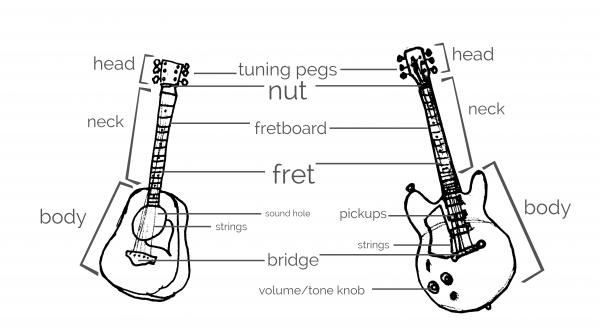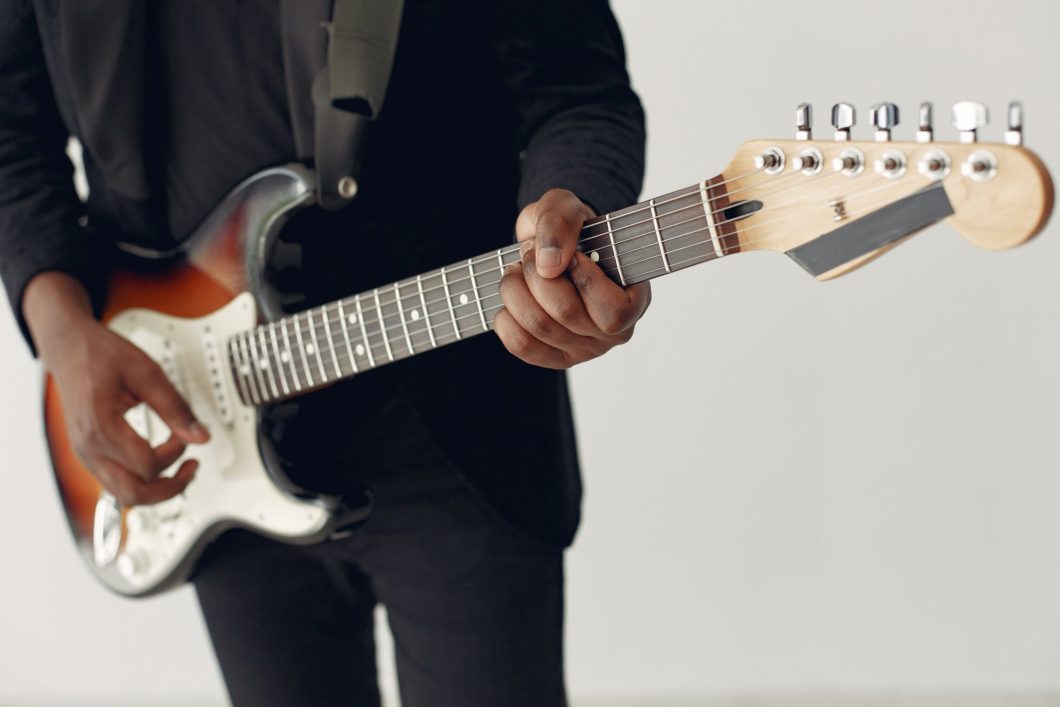In the immortal words of Radiohead, “Anyone can play guitar.”
And they’re right. That’s the great thing about the guitar. It’s for everyone!
But how do we talk about it? What’s the name for those metal things at the top of the guitar?
What about that fun noise you make when you put the guitar right in front of the amp?
Let’s look at these!
And then we can talk about playing guitar as well as … well … actually playing it.
Parts of the guitar
Why explain this when I show you this lovely image that I drew?
Trust me – guitars are weirdly difficult to draw.

Guitar accessories
So that’s the guitar itself.
But what about all those extra bits?
There are loads of accessories for the guitar. Here are the most common ones:
- Strap
So you play guitar in a band – great!
But it doesn’t look too cool if you’re sitting down all the time, right?
You want to stand up and maybe even jump around.
So you get a strap and hang the guitar on your shoulder.
- Stand
Where do you put the guitar when you’re not using it?
You could just leave it lying on the floor. Not a good idea.
Get a stand so you can put it upright and safe.
- Capo
Have you ever tried to work out how to play a song just by listening to it?
You listen to the song again and again and try to figure out what chords are being played.
You get nowhere, so you look it up online.
Then you discover that you actually need a capo to play this one.
A capo fits between frets and brings the pitch of the guitar up without you having to retune.
- Amp
You’ve got an electric guitar – nice one!
But it sounds rubbish by itself.
You need to plug it in to be able to hear it.
So you need to plug it into an amp– short for amplifier.
- Cable
But what do you plug it in with?
You need something to connect the guitar to the amp.
That’ll be a cable.
They always disappear after you’ve played a gig (concert).
- Effects pedal
What’s the point in getting an electric guitar if you’re just going to plug it directly into the amp?
The fun of playing an electric is using effects pedals and making the guitar louder and more aggressive or strange and mysterious.
Pedals can do anything!
- Guitar case
What about transporting it?
You can’t just take the guitar straight on the plane, right?
You want to put it into a kind of bag – or guitar case.
You can get hard cases and soft cases.
- Pick / Plectrum
Sure, you can play with your fingers.
But if you want to make a bigger sound, you’ll need a plectrum (though most people call them picks).
It’s the thin piece of plastic you use to strum the guitar with.
- Tuner
Some people can tune the guitar without even thinking about it.
Most of us can’t.
So we use our old friend, technology, to do the work for us.
These days you can just get a phone app instead of an actual tuner.
Things related to playing guitar
- Tune
It sounds awful! You need to tune it.
Basically you need to get the strings to EADGBE.
Or you might be using alternative tuning, open tuning (when it sounds great without you using your left hand) or the popular drop D tuning– used mostly by Kurt Cobain.
- Right-hand technique
How you use your right hand.
- Left-hand technique
How you use your garlic crusher.
No, that’s not it.
Yeah – it’s how you use your left hand.
- Strum
This is when you play all (or most of) the strings more or less at once instead of one at a time.
Strumming is more common on acoustic guitars than on electric ones.
- Upstroke / Downstroke
When you strum, there are just two directions to go – up or down.
- Fingerpicking
If you’re not strumming, you’re probably fingerpicking – playing each
string individually or even a couple at once, instead of all the
strings at once.
It’s more intricate. Think about what Slash does while he’s doing his best to look cool in the most ‘80s way possible.
- Finger tapping
This is when you use both your right hand and your left hand on the fretboard.
There’s no strumming and no fingerpicking.
Instead, you’re playing the guitar more like a piano.
This technique was popularized by Van Halen and is a bit of a rock cliché.
- Pluck
This simply means to play a single string. Usually with a pick.
- Riff
Rock music is completely based on “the riff.”
A riff is small sequence of chords or notes repeated again and again. It’s what makes the song likeable and memorable.
Think of the classic “Smoke on the Water.”
Or “Sweet Child o’ Mine.”
- Harmonics
Harmonics are great fun.
If you lightly touch the string above some of the frets (3rd, 5th,
7thand especially 12th) and then pluck it, you get a harmonic – and
mysterious, high-pitched ringing sound.
Some bands really go crazy with their harmonics. Sometimes too much.
I’m looking at you, Pantera.
- Feedback
Some bands use too many harmonics.
And some bands use too much feedback.
This time it’s Nirvana who’s guilty.
You get feedback when you put the guitar right in front of the amp
(preferably with some kind of distortion pedal). The resulting sound is a
noise best compared to a screaming baby.
- Mute
This is popular with metal bands and used a lot in metal riffs.
Basically you lightly cover the strings, either with your left hand or with the bottom of your right hand, and strum.
You get something between a clicking sound and a heavy, deep sound.
This is a verb, so you “mute the strings.”
- Slide
You know when you slide your left hand from one fret to another one?
Well, that’s called a slide.
It can be a noun (“Nice slide, man!”) or a verb (“Slide up to 12that the end of the riff.”)
- Bend
This is another logically named one.
This is when you pull the string down (or up) a little with your left hand.
The pitch of the note bends up a little.
Again, this can be a noun (“Too many bends in this solo”) or a verb
(“OK – what if we bend the note in the middle of the riff?”).
- Scrape
This one is pretty common in punk music. Especially that rather
annoying ‘90s American punk (like NOFX) that I secretly enjoy listening
to.
But how to do it?
You take the pick, put it between two strings (the thicker ones work best) and slide it along the neck.
You get a sort of mechanical noise.
- Hammer on / Hammer off
You’re holding a note with one finger. Then you bring another finger
down onto a higher fret on the same string, changing the note. That’s a
hammer on.
When you do it the other way round (holding a note and then releasing it), it’s called a hammer off.
- Open chord
These are the chords you make when you start learning the guitar.
They all happen up at the top of the neck near the nut and always have at least one open string.
- Bar chord
I remember when I was first able to use bar chords. It was like I could play anything!
You make a bar chord by putting your left index finger over all the
strings on a particular fret. Then you can make other chords on the
frets above it. You can then move one shape all the way up and down the
fretboard.
And there we have it – essential guitar vocabulary in English.
Radiohead were right: anyone can play guitar. But not everyone can talk about playing guitar.
Now you can!
And don’t forget to check our English with LOS Songs.
Gabriel Clark, LOS Consultant & Clark and Miller Co-founder
